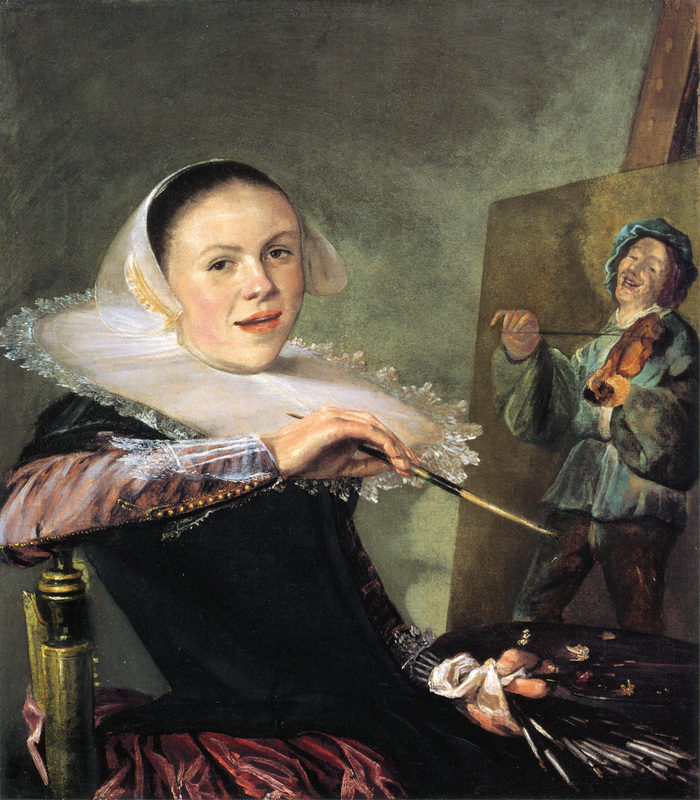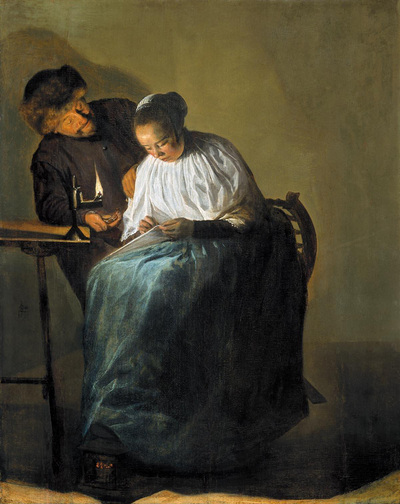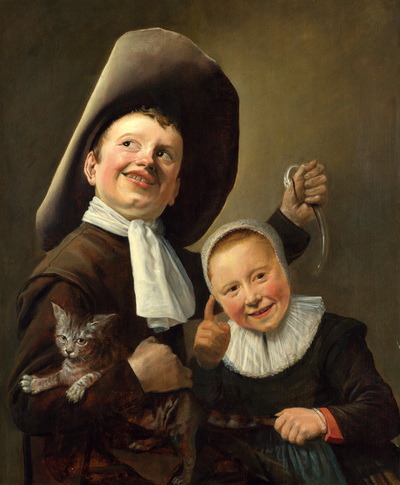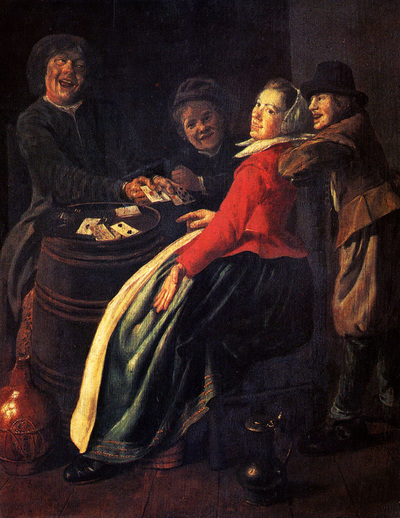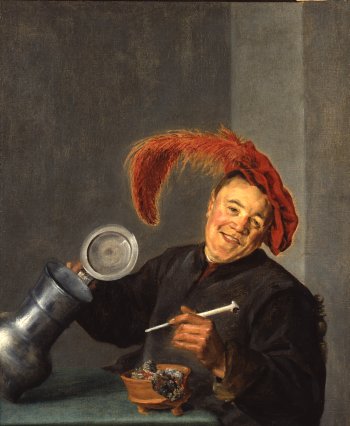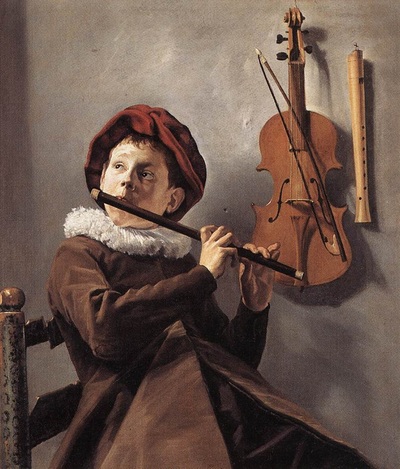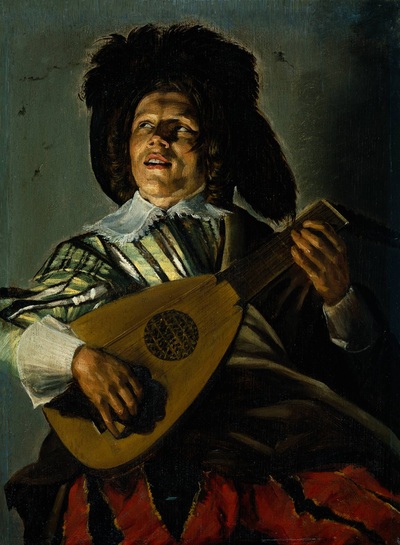JUDITH LEYSTER 1609 - 1660No shooting stars today Haarlem 1635 - the Golden Age which culminated in about 700 artists active as painters in the Netherlands who did approximately 70,000 pieces a year had only just begun. Although only 19 years old, Judith Leyster was referred to as " a painter of good and keen insight" in Samuel Ampzing's description of Haarlem. At the age of 26 she was running a thriving artist's studio with 3 apprentices. The majority of her roughly 60 works had been finished by this time. In the course of her career she also met the painter Jan Miense Molenaer. By accepting commissioned work such as portraits and by painting genre scenes of children, musicians, and get-togethers sold in the public market she was able to earn a living. Leyster's genre paintings show a remarkable intimacy which had not been present in this type of artwork before. Her brush stroke is easy, almost sketchy. She uses the effect of dramatic light by contrasting it with very dark areas. Apart from the similarity to Frans Hals the influence of the Utrecht Caravaggists is apparent in her pictures as well. With a self-portrait she applied to the Haarlem Guild of St. Luke for admission in 1633, was indeed accepted and became the only female member in a group of 30. This portrait shows a woman expensively dressed, obviously successful, radiating self-assurance and cleverness and looking as if she were about to talk to us. A clever move also the choice of the picture-in-the-picture which had originally been intended to show herself. She changed her mind though and replaced it with a picture which showed prospective buyers what she was able to do. She was clever, one of the best in terms of workmanship and prepared to go to any lengths to reach her goals. Her signature is similarly evocative. Leyster means "lode star" or "pole star" (comet) in Dutch, and even at the time she was described as a leading star in the arts scene. She made use of this pun by attaching a shooting star to her initials. http://lookingaroundabit.blogspot.de/2009/09/guiding-star-lost-and-found-judith.html The symbolism her signature involves at the height of her career extends to other areas as well. Membership in the Guild not only earned her recognition as a painter but enabled her to gain access to the official arts market as well where she became acquainted with Frans Hals and a number of other renowned artists. It is assumed that she remained close to him all her life. Records indicate that she was present at the christening of one of Hals's children. It is not clear by whom she was trained but as her work and that of Frans Hals are so very much alike, many of her pictures were declared to be by Frans Hals in the course of history until Louvre staff discovered her signature under Frans Hals's false one. This is not the only reason however why her signature, her work and her identity as an artist disappeared from the history of art. After her marriage in 1636 she and Molenaer worked collaboratively together, shared a studio, used the same requisites and worked on the same paintings. As a result it is difficult in retrospect to positively attribute the pieces to either her or him, especially as she had assumed his name and no longer signed "Leyster", but "Molenaer", "Miss" or even "Mrs Molenaer" instead. For all those reasons hardly any works are known painted by her during the time of her marriage. To retrace the story of Judith Leyster her signature and her name are the only reliable evidence. 200 years later the Washington National Gallery of Art dedicated an exhibition to her. Gitte Jabs Scroll down for German Version Sources: Schulz Isabell, Die Frau als Künstlerin, Hamburg 1986 Nancy Heller, Künstlerinnen. Von der Renaissance bis zur Gegenwart, 1989 Exhibition Reviews: Reasons to look Back: Judith Leyster Nationa Art Gallery, Aneta Georgievska-Shine http://www.findagrave.com/cgi-bin/fg.cgi?page=gr&GRid=39889076 (Bob Hufford) http://lookingaroundabit.blogspot.de/2009/09/guiding-star-lost-and-found-judith.html |
JUDITH LEYSTER 1609 - 1660Heute keine shootingstars
Haarlem 1635, das goldenen Zeitalter hat gerade begonnen, auf dessen Höhepunkt in den Niederlanden ca. 700 Maler arbeiteten, die jährlich etwa 70.000 Gemälde fertigstellten. Grade erst 19-jährige wurde Judith Leyster in Samuel Ampzing’s Beschreibung Haarlems als “Malerin von gutem und wachen Verständnis” erwähnt. Mit 26 betrieb Sie ein gut gehendes Atelier mit 3 Schülern, schuf bis zu diesem Zeitpunkt die meisten ihrer rund 60 Werke und lernt Jan Miense Molenaer kennen, der ebenfalls Maler war. Sie lebte von Portraits auf Kommission und Genrebildern für den öffentlichen Markt, die oft Kinder, Musiker und Szenen geselligem Beisammenseins zeigten. Neu bei Leyster zu vorherigen Genrebildern ist bei Ihr die bemerkenswerte Intimität der Bilder. Ihr Pinselstrich war locker, fast skizzenhaft. Ausser der Nähe zu Frans Hals zeigen ihre Bilder den Einfluss der Utrechter Caravaggisten und strake hell-dunkel Kontraste mit dramatischem Licht. Ihr Selbstportrait entstand 1633 zu Präsentationszwecken für die Aufnahme in die Haarlemer St. Lukas Gilde, dessen einziges weibliches unter 30 Mitgliedern sie wurde. Das Portrait zeigt sie intellektuell, in guter Kleidung, erfolgreich, als würde sie gerade zu uns sprechen wollen. Klug ist auch die Wahl des Bildes im Bild, das den Käufern zugleich ihr Produkt präsentierte. Sie war clever, handwerklich begabt und zu Allem entschlossen. Ähnliches sagt uns auch ihre Signatur. Leyster heisst „lode star oder polestar“ (Komet) auf niederländisch und schon damals wurde sie als leitender Stern in der Kunstszene beschrieben. Sie benutzte dieses Wortspiel und verband ihre Initialen mit einer Sternschnuppe einem „shooting star“. http://lookingaroundabit.blogspot.de/2009/09/guiding-star-lost-and-found-judith.html So symbolisch wie die Signatur am Höhepunkt ihrer Karriere ist, so ist sie es auch an anderer Stelle. Die Mitgliedschaft in der Gilde verschaffte ihr nicht nur Anerkennung als Malerin, sondern öffnete ihr auch Zugang zum offiziellen Kunstmarkt. Dort traf sie mindestens auf einen Bekannten: Frans Hals. Von wem Leyster ihre Ausbildung erhielt ist nicht klar, ihres und Frans Hals Werk sind sich aber so nah, das viele Ihrer Bilder im Laufe der Geschichte zu seinen erklärt wurden. Das ist nicht der einzige Grund für das Verschwinden ihrer Signatur, ihrer Arbeit und Person aus der Kunstgeschichte. Nach ihrer Heirat 1636 arbeiteten Sie und Molenaer kollaborativ zusammen, benutzten eine gemeinsamen Werkstatt, die gleichen Requisiten und malten an den gleichen Bildern, was es schwierig macht beider Werke im Nachhinein zu definieren. Hinzu kommt, dass Sie seinen Namen annahm und nicht mehr mit dem „Leyster“ unterschrieb, sondern mit „Molenaer“, „Miss Molenaer“ oder sogar „Frau“. Aus der Zeit Ihrer Ehe sind deshalb kaum Bilder von ihr bekannt. Die Geschichte Leysters ist die Ihrer Signatur und diese galt 200 Jahre als verschwunden, bis 1983 Mitarbeiter des Louvre ihre unter der falschen Signatur Frans Hals´ entdeckten, das Interesse an Ihrem Werk geweckt wurde. 2009 widmete die National Galerie Washington ihr eine Ausstellung. Gitte Jabs Scroll up for English version Quellen: Schulz Isabell, Die Frau als Künstlerin, Hamburg 1986 Nancy Heller, Künstlerinnen. Von der Renaissance bis zur Gegenwart, 1989 Exhibition Reviews: Reasons to look Back: Judith Leyster Nationa Art Gallery, Aneta Georgievska-Shine http://www.findagrave.com/cgi-bin/fg.cgi?page=gr&GRid=39889076 (Bob Hufford) http://lookingaroundabit.blogspot.de/2009/09/guiding-star-lost-and-found-judith.html |
